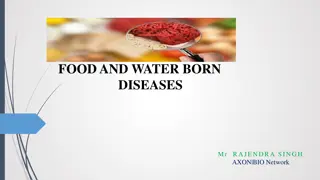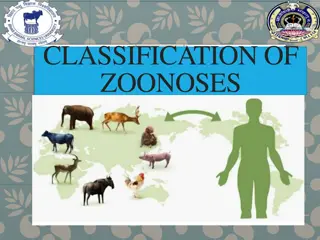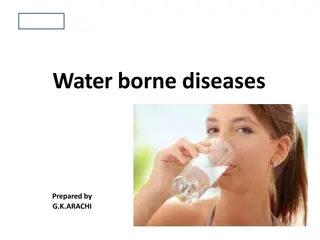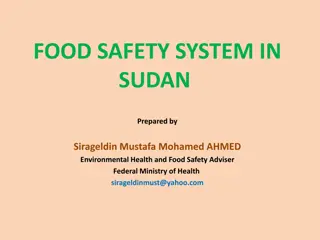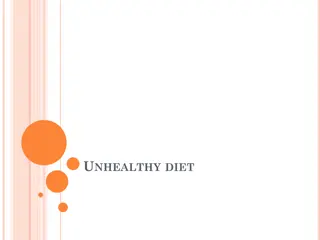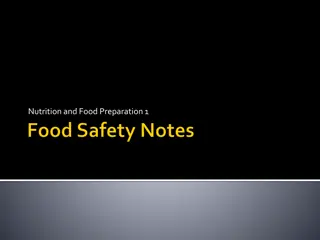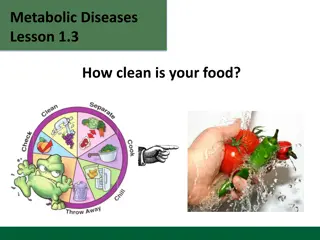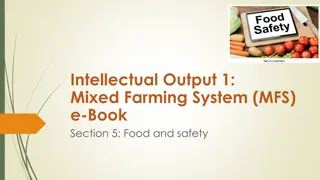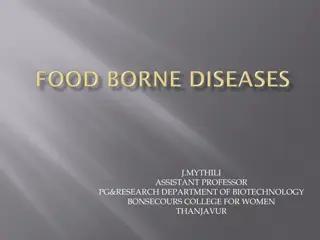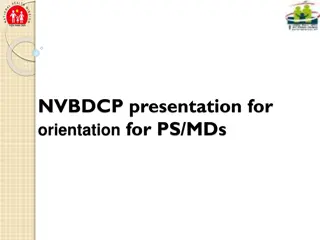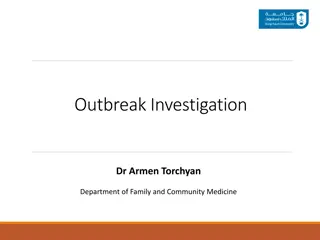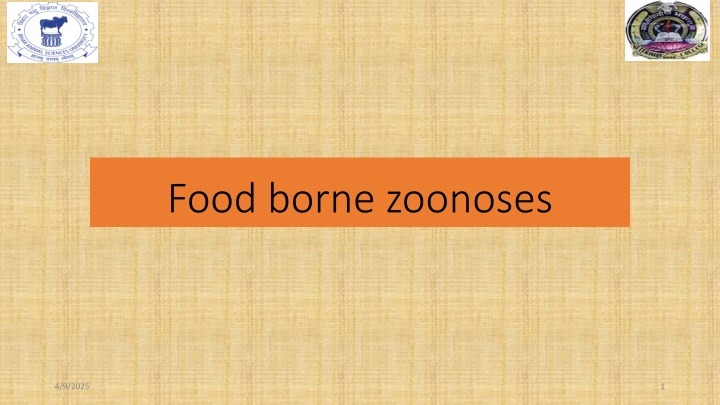
Food-borne Zoonoses and Bacterial Toxins
Explore the world of food-borne diseases, bacterial toxins, and infections with insights on viral and parasitic infections, bacterial endotoxins, and common pathogens causing food-borne illness. Learn about food infection, food intoxication, and toxi-infection along with characteristics of bacterial endotoxins and classic exotoxins. Dive into the details of invasive infections, toxicoinfections, and intoxication caused by pathogens like Salmonella, Bacillus cereus, and more.
Uploaded on | 3 Views
Download Presentation

Please find below an Image/Link to download the presentation.
The content on the website is provided AS IS for your information and personal use only. It may not be sold, licensed, or shared on other websites without obtaining consent from the author. If you encounter any issues during the download, it is possible that the publisher has removed the file from their server.
You are allowed to download the files provided on this website for personal or commercial use, subject to the condition that they are used lawfully. All files are the property of their respective owners.
The content on the website is provided AS IS for your information and personal use only. It may not be sold, licensed, or shared on other websites without obtaining consent from the author.
E N D
Presentation Transcript
Food borne zoonoses 4/9/2025 1
EVENTS OF FOOD BORNE DISEASES Viral or Parasitic infection Reservoir of Pathogen Contamination of food Growth of pathogenic bacteria Food+ Live cells Food +Toxin Mycotoxin Intoxication Infection Invasive Infection Toxicoinfection 4/9/2025 Unit 1 Lecture 12 2
BACTERIAL TOXIN ENDOTOXIN EXOTOXIN
CHARACTERISTICS OF BACTERIAL ENDOTOXINS AND CLASSIC EXOTOXIN PROPERTY ENDOTOXIN EXOTOXIN CHEMICAL NATURE LPS (mw = 10kDa) Protein (mw = 50-1000kDa) RELATIONSHIP TO CELL HEAT STABILITY ANTIGENIC Part of outer membrane Yes (600 C) Yes Extracellular, Diffusible Relatively No Yes FORM TOXOID No Yes POTENCY Relatively low (100ug) Relatively high (1 ug) SPECIFICITY Low degree High degree ENZYMATIC ACTIVITY No Often PYROGENICITY Yes Occasionally SYNTHESIS CONTROL Chromosomal gene Extrachromosomal gene
Food infection. The ingestion of viable pathogenic bacteria alongwith the food leads to their lodgement and establishment in consumers organ. This is called as Foodinfection . Food intoxication. Ingestion of toxins already produced by microorganisms in the food brings about poisoning syndromes in the consumers. This is called as Foodintoxication . Toxi-infection. A certain group of organisms which can infect intestines when ingested alongwith the food and produce toxins in situ to bring about symptoms of poisoning. This condition is called as toxi- infection . 4/9/2025 Unit 1 Lecture 12 6
Invasive Infection Toxicoinfection Intoxication o Salmonella o Bacillus cereus (Diarrhoel) o L. monocytogenes o E. coli ( enteric type) o Staph. Aureus o Cl.botulinum ( Infant) o Cl . perfringens o B.Cereus (Emetic type) o Shigella o Campylobacter o Cl. botulinum o Vibrio cholarae o Yersinia o E. Coli (Enterotoxigenic) o Vibrio parahaemolyticus o Aeromonas 4/9/2025 Unit 1 Lecture 12 7
Important helminthic zoonoses Flukes: Tapeworms: Taeniosis/Cysticercosis Fasciolosis: (F. gigantica, F. hepatica) Hydatidosis Diphyllobothriosis Fasciolopsosis:(Fasciolopsis buski) Sparganosis Amphistomosis: (Gastrodiscoides hominis) Nematodes: Schistosomosis/Cercarial Dermatitis: Animal and bird schistosomes Visceral Larva Migrans/Ocular Larva Migrans Cutaneous Larva Migrans/Eosinophilic Enteritis Paragonimosis: Paragonimus westermanii Gnathostomosis Filariosis
Food borne viral zoonoses Rota virus Astrovirus Poliovirus Adenoviruses Norwalk virus Arenavirus Picornaviridae Hantavirus Foot-and-Mouth Disease virus Hepatovirus Hepatitis A & E virus Aichi virus 4/9/2025 Unit 1 Lecture 12 12
Thanks 4/9/2025 Unit 1 Lecture 12 13



